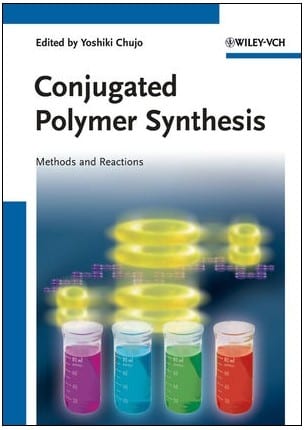 Conjugated Polymer Synthesis: Methods and Reactions
Conjugated Polymer Synthesis: Methods and Reactions
Yoshiki Chujo (Editor)
Hardcover
328 pages
January 2011
Conjugated polymers are novel materials that possess not only the optoelectronic properties of semiconductors but also the mechanical properties and the processing advantages of polymers. Research into conjugated polymers has become an integrated area that includes chemistry, physics, and material sciences.
On the one hand conjugated polymers have opened the way to progress in understanding the fundamental chemistry and physics of π-bonded macromolecules, while on the other hand conjugated polymers have been found many applications, such as light-emitting materials, photovoltaic materials, thin film transistors, chemo/biosensors, and so on.
Research on conjugated polymers has twice been awarded Nobel prizes in chemistry – the Nobel Prize for Chemistry in 2000 to Professors Alan Heeger, Alan MacDiarmid, and Hideki Shirakawa for their discovery that “doped” polyacetylene can conduct electricity and the Nobel Prize for Chemistry in 2010 to Professors Richard F. Heck, Ei-ichi Negishi, and Akira Suzuki for their invention of novel palladium-catalyzed cross couplings that can be used for the convenient synthesis of organic and conjugated polymer materials. Nowadays, the synthesis of conjugated polymers is still a quickly developing area that has drawn particular attention worldwide.
The book entitled Conjugated Polymer Synthesis, edited by Yoshiki Chujo, successfully highlights the most recent advances in the area of conjugated polymer synthesis. This book includes 11 chapters, which are written by internationally acclaimed experts, and focus on the major developments in the topics of synthesis of new conjugated polymers, novel methodologies for the preparation of conjugated polymers, and inorganic-elements containing main chain-type conjugated polymers. The content of this book is not only composed of the synthesis of conjugated polymers, but also the applications of conjugated polymers in material sciences. The first chapter written by Takakazu Yamamoto summarizes the most important advances of the synthesis of conjugated polymers with nickel complex mediated C-C coupling reaction, which is now widely known as Yamamoto coupling, and the photophysical properties of the as-synthesized polymers.
The second and the third chapters are concerned the recent most important advances on the synthesis of conjugated polymers. In the second chapter, Tsutomu Yokozawa describes the synthesis of conjugated polymer by catalyst transfer polycondensation. In the third chapter, Itaru Osaka and Richard D. McCullough discuss the synthesis of regioregular poly(3-alkylthiophene)s by Ni-complex catalyzed living polycondensation. Using synthetic methods described in the above mentioned two chapters, conjugated polymers with a narrow molecular weight distribution and conjugated polymers with di-block structures can be prepared.
The fourth chapter by Ben Zhong Tang et al. summarizes the recent advances of synthesis of functional hyperbranched conjugated polymers. Chapter 5 written by Yasuhiro Morisaki and Yoshiki Chujo deals with through space conjugated polymers, which are composed of layered aromatic rings in a single polymer chain, in which the charges and energy are mainly transferred by hoping mechanism.
Chapter 6 written by Masayoshi Takase and Masahiko Iyoda treats of the synthesis and properties of shape-persistent conjugated nano-sized macrocycles, focusing on the recent developments in planar or nearly planar giant π-conjugated macrocycles with particular regard to the synthetic methods and their versatile properties. Because of their unique structures and novel properties, shape-persistent giant macrocycles have attracted much attention in supramolecular chemistry and materials science, and they are of interest for structure-property relationships, one-dimensional (1D) and two-dimensional (2D) nanostructures, and single molecule electronics owing to the efficient guest incorporation and electronic properties depending on their sizes and supramolecular structures.
Chapter 7 by Atsushi Nagai and Yoshiki Chujo, chapter 8 by Paul W. Siu and Derek P. Gates, and chapter 9 by Kensuke Naka and Yoshiki Chujo describe recent examples of exotic element-containing conjugated polymers, which include the synthesis and applications of boron atom, phosphorous atom, arsenic atom, and antimony atom containing π-conjugated polymers. As definition, metallopolymers are organic polymers that contain metals. Researches on metallopolymers have become one of the fastest developing fields in macromolecular chemistry. Chapter 10 written by Ulrich S. Schubert et al. summarizes the synthetic strategies to conjugated main-chain metallopolymers. Three kinds of representative metallopolymers, which contain terpyridines, porphyrins, and metallaynes within the polymer main chain, have been highlighted in this chapter.
The final chapter, written by kazoo Akagi, discusses the preparation of helical polyacetylene with a super-hierachical structure in an asymmetric reaction field consisting of chiral nematic liquid crystal (LC). The films prepared with this method exhibit high electrical conductivities of 1.5 ~ 1.8 × 103 S cm-1 after doping with iodine. This opens the possibility of preparing other conjugated polymer superstructures with the nematic LC as an asymmetric medium for polymerization.
This book can be considered a very useful handbook for organic, polymer, and materials scientists who are interested in the chemistry and optoelectronic properties of conjugated polymers.

















